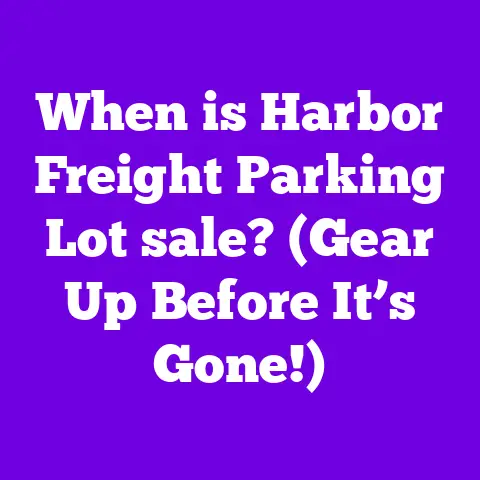When Do Last Year’s Cars Go on sale? (Dealers Desperate!)
Imagine this: a showroom floor gleaming with the latest models, their paint jobs reflecting the fluorescent lights like a futuristic dream.
Now picture the back lot, a silent graveyard of perfectly good, slightly older vehicles, each day diminishing in value.
This is the reality for car dealers every year, a ticking clock counting down to the moment they need to clear out the old to make way for the new.
The pressure is on, and in 2025, the stakes are even higher.
As I delve into the world of automotive sales, I’ll uncover the strategies, the timing, and the desperate measures dealers are taking to offload last year’s inventory.
If you’re in the market for a new ride, understanding these dynamics can save you thousands.
I’ll explore the automotive sales cycle, the unique market landscape of 2025, dealer tactics, consumer behavior, and even offer predictions for the future of car sales.
Buckle up, because the ride is about to begin.
The Automotive Sales Cycle: A Race Against Time
The automotive industry operates on a well-defined schedule.
New models typically roll out in the late summer or early fall.
This creates a ripple effect, pushing dealers to clear out the previous year’s models to make room.
But it’s not as simple as flipping a switch.
The Annual Dance of Inventory
Manufacturers and dealers meticulously plan their inventory.
They consider factors like anticipated demand, production capacity, and economic forecasts.
The goal is to strike a balance: enough cars to meet consumer needs, but not so many that they’re left with a surplus of outdated models.
The timing of when last year’s models go on sale is influenced by several elements:
- New Model Arrival: The imminent arrival of the latest models is the primary catalyst.
Dealers need space and capital to showcase and sell the new vehicles. - Manufacturer Incentives: Automakers often provide incentives to dealers to clear out older inventory.
These incentives can include rebates, financing deals, and marketing support. - Economic Conditions: A strong economy generally leads to higher car sales, reducing the pressure on dealers to discount last year’s models.
Conversely, a weaker economy can accelerate the need to move inventory. - Consumer Demand: If a particular model remains popular even after the new version is released, dealers may be able to hold out for higher prices.
However, this is rare. - Production Timelines: Supply chain disruptions, like the recent chip shortages, can throw a wrench into the entire cycle.
Delays in new model production can give dealers more time to sell older inventory at near-full price.
Impact of External Factors
Economic trends, consumer demand, and production timelines play a crucial role.
For example, during the 2008 financial crisis, car sales plummeted, forcing dealers to slash prices on all inventory, including last year’s models.
Similarly, the COVID-19 pandemic created massive disruptions in the supply chain, leading to both inventory shortages and unpredictable pricing.
The 2025 Market Landscape: A Unique Set of Challenges
The automotive market in 2025 is far from ordinary.
Several factors are creating a unique environment that impacts the availability and pricing of last year’s cars.
Lingering Effects of Supply Chain Issues
The global chip shortage, which began in 2020, continues to affect production in 2025.
While the situation has improved, manufacturers are still struggling to meet demand for certain models.
This has a direct impact on the availability of both new and used cars.
“The chip shortage is still a factor, though less severe than in previous years,” says automotive analyst Jessica Caldwell.
“Manufacturers are prioritizing production of their most profitable models, which means some less popular vehicles may be in short supply, even as last year’s models.”
Economic Uncertainty
Inflation and rising interest rates are also impacting consumer behavior.
Many potential buyers are delaying purchases or opting for more affordable options.
This puts additional pressure on dealers to move last year’s inventory quickly.
The Federal Reserve’s interest rate hikes have made auto loans more expensive, further dampening demand.
According to data from Experian, the average interest rate for a new car loan in Q1 2024 was 7.26%, up from 4.52% in Q1 2022.
This increase significantly impacts affordability, leading some consumers to consider used or older models instead.
Shift Towards Electric Vehicles
The growing popularity of electric vehicles (EVs) is another factor to consider.
As more consumers embrace EVs, demand for traditional gasoline-powered cars may decline, making it harder for dealers to sell last year’s gas-powered models.
Table: Projected EV Market Share (2023-2027)
Source: Kelley Blue Book
This shift towards EVs is forcing dealers to adapt their strategies.
Some are offering aggressive discounts on last year’s gasoline-powered models to make room for new EVs.
Dealer Strategies for Selling Last Year’s Cars: A Battle for the Bottom Line
Dealers employ a range of strategies to sell last year’s inventory, from straightforward discounts to more subtle psychological tactics.
The Discount Dance
The most common tactic is, of course, discounting.
Dealers will typically offer significant price reductions on last year’s models to entice buyers.
These discounts can range from a few hundred dollars to several thousand, depending on the model, the dealer, and the market conditions.
In addition to direct price cuts, dealers may also offer:
- Rebates: Cash-back offers from the manufacturer or the dealer.
- Financing Deals: Low-interest or zero-percent financing options.
- Lease Specials: Attractive lease terms with lower monthly payments.
- Trade-In Bonuses: Increased value for trade-in vehicles.
The Art of Persuasion
Beyond discounts, dealers use psychological tactics to create a sense of urgency and scarcity.
These tactics include:
- Limited-Time Offers: Emphasizing that the discounts are only available for a short period.
- Scarcity Marketing: Highlighting the limited availability of certain models or colors.
- Emotional Appeals: Using advertising that plays on buyers’ emotions, such as the desire for status or the fear of missing out.
Case Study: Navigating the 2024 Inventory Challenge
Consider the case of “Prestige Motors,” a dealership in a major metropolitan area.
In 2024, they faced the challenge of clearing out a large inventory of 2023 sedans amid rising interest rates and increasing EV adoption.
Their strategy involved:
- Aggressive Discounts: Offering discounts of up to 15% on 2023 models.
- Low-Interest Financing: Partnering with a local credit union to offer below-market financing rates.
- Targeted Marketing: Focusing on specific demographics, such as families looking for affordable and reliable transportation.
- Community Engagement: Hosting local events and sponsoring community initiatives to build goodwill and attract customers.
By implementing these strategies, Prestige Motors successfully cleared out their 2023 inventory and positioned themselves for a successful 2024.
Consumer Behavior and Buying Trends: Shifting Priorities
Consumer preferences are constantly evolving, and in 2025, several trends are shaping the car-buying landscape.
The Rise of Online Research
More and more consumers are conducting their car research online before ever stepping foot in a dealership.
They use websites like Kelley Blue Book, Edmunds, and Car and Driver to compare models, read reviews, and check prices.
This trend has several implications:
- Increased Transparency: Buyers are more informed and have a better understanding of market prices.
- Reduced Bargaining Power: Dealers have less room to negotiate because buyers can easily compare prices online.
- Importance of Online Reputation: Dealerships with positive online reviews and ratings are more likely to attract customers.
Demographic Influences
Demographic factors also play a significant role.
For example, younger buyers are more likely to be interested in fuel-efficient or electric vehicles, while older buyers may prioritize comfort and safety.
The Urgency Factor
The urgency to buy a car is influenced by several factors, including:
- Personal Needs: A growing family or a failing vehicle can create a sense of urgency.
- Economic Conditions: A strong economy can encourage buyers to make a purchase, while economic uncertainty can lead to delays.
- Marketing Tactics: Dealers use limited-time offers and other tactics to create a sense of urgency.
The Future of Car Sales: Predictions and Trends
The automotive industry is undergoing a period of rapid change, and the way cars are sold will likely evolve significantly in the coming years.
The Electric Revolution
The shift towards electric vehicles is perhaps the most significant trend.
As EVs become more affordable and offer longer ranges, they will continue to gain market share.
This will impact the sale of last year’s gasoline-powered cars, potentially leading to even steeper discounts.
Subscription Services
Car subscription services, which allow consumers to pay a monthly fee for access to a vehicle, are also gaining traction.
These services offer flexibility and convenience, and they could disrupt the traditional car ownership model.
Online Sales
The online car-buying experience is becoming increasingly sophisticated.
Some manufacturers are even offering direct-to-consumer sales, bypassing the traditional dealership model altogether.
Conclusion: Timing is Everything
The timing of when last year’s cars go on sale is a complex dance influenced by a multitude of factors, from manufacturer incentives to consumer demand.
In 2025, the lingering effects of supply chain issues, economic uncertainty, and the growing popularity of electric vehicles are creating a unique set of challenges for dealers.
For consumers, understanding these dynamics is crucial.
By doing your research, being patient, and being willing to negotiate, you can potentially save thousands of dollars on a new car.
Remember, the key is to strike at the right moment, when dealers are most desperate to clear out their inventory.
The clock is ticking, and the deals are waiting to be discovered.






